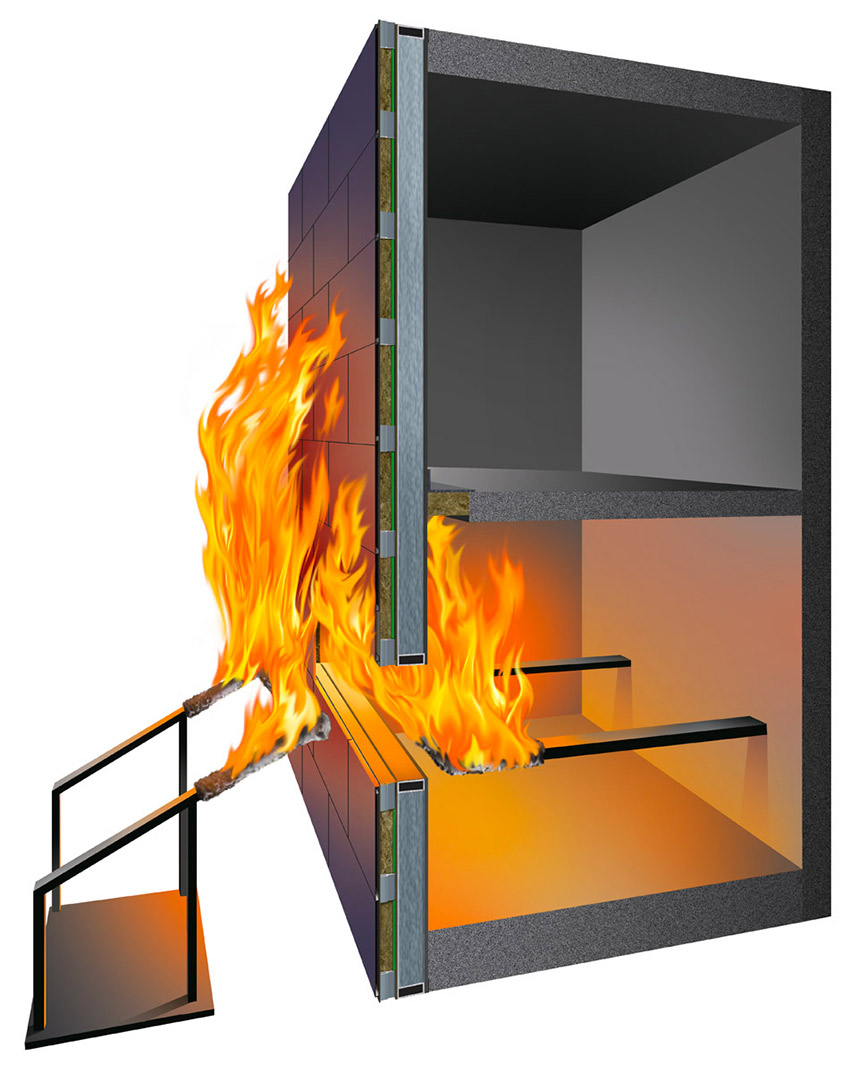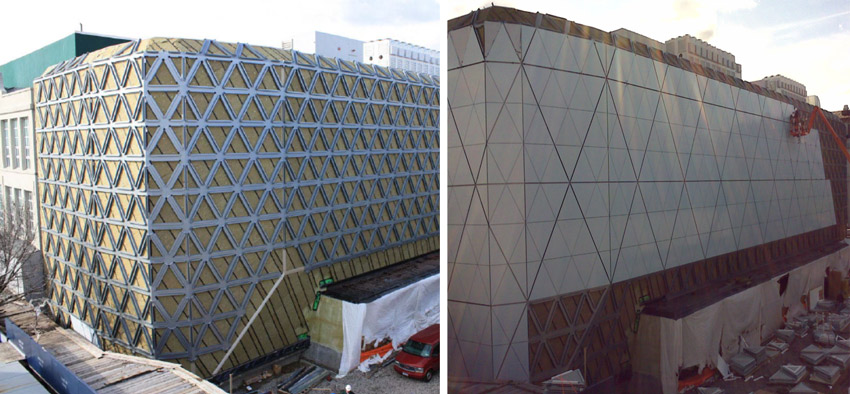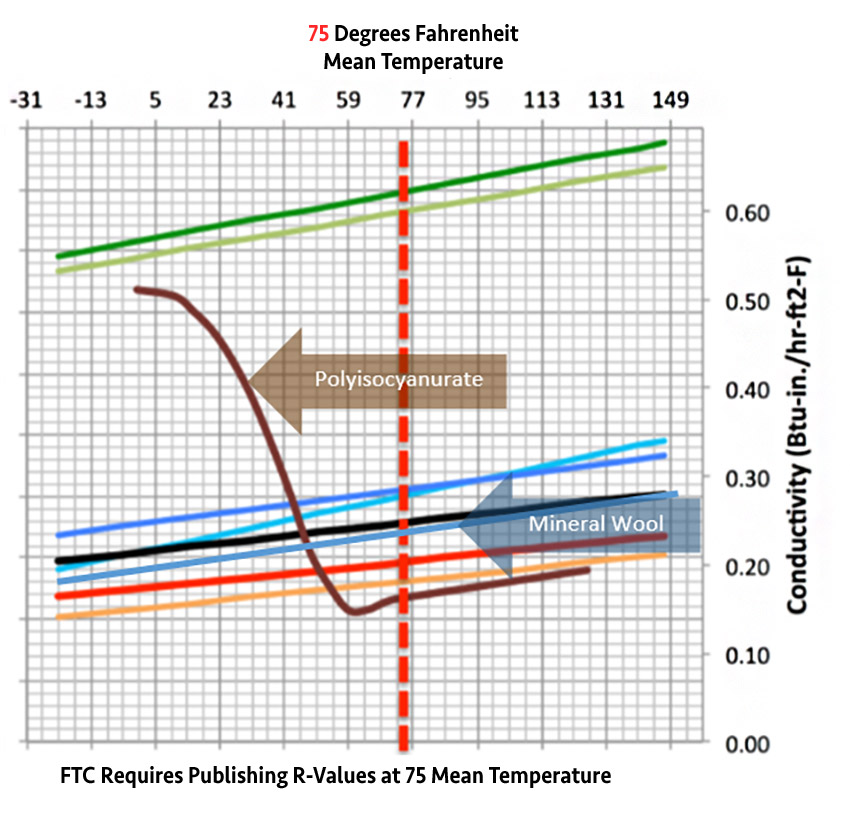Mineral Wool as a Continuous Insulation Solution
NFPA 285 Fire Test
NFPA 285 is an intermediate scale wall system fire test. It measures what happens during a fire when combustible materials such as foam plastic ci, combustible air barriers, or combustible claddings are included as part of the exterior wall assembly. This is not a new test. NFPA 285 has been featured in multiple sections of the International Building Code (IBC) for several years. However, it started to gain increased awareness when the energy standards, such as ASHRAE 90.1, began prescribing continuous insulation and requiring air barriers, both of which are sometimes combustible.

This illustration depicts the NFPA 285 fire test being conducted on a wall with mineral wool as the exterior wall cavity insulation as well as continuous insulation with a metal panel cladding.
The purpose of NFPA 285 is to limit fire spread via exterior wall surfaces, thereby enhancing the life safety of building occupants and protecting the building itself. Shown below are four examples of real building fires. They exhibit the types of fire spread that NFPA 285 aims to limit. None of these fires started within the exterior wall system; however, combustible materials allowed the fire to quickly spread up the structure.
The Address Downtown Dubai Hotel | Dubai, United Arab Emirates
Reports indicated that an electrical short circuit on a spotlight caused the major fire that engulfed The Address Downtown Dubai hotel on New Year’s Eve 2015. According to police, the blaze was triggered by a spark from cables connected to the light, which sat on a ledge between the 14th and 15th floors of the 63-story tower. Police concluded that the alarms did not sound immediately because the fire had started on the outside of the building, therefore smoke had not yet set off internal alarms.1
Wooshin Golden Suites | Busan, South Korea
In October 2010, the Wooshin Golden Suites apartment building in South Korea experienced a fire that started on the fourth floor in a garbage collection room. Reports indicate that the building had a working sprinkler system, but it is reported that the code didn’t require sprinklers in that room. According to reports, by the time the fire spread from the point of origination, it overwhelmed the sprinklers, traveled out a window, and spread up the exterior via combustible paint on aluminum wall panels.2
TVCC/Mandarin Oriental Hotel | Beijing, China
Reports blamed the February 2009 40-story office building fire in TVCC/Mandarin Oriental Hotel in Beijing, China, on fireworks that landed on the roof, igniting the roof and allowing the fire to spread from the top to the bottom of this building in approximately 13 minutes. The fire burned through the thin metal wall cladding and ignited the flammable insulation layer below the metal.3
Monte Carlo Resort & Casino | Las Vegas
In January 2008, fire investigators determined that workers on the roof with welding torches ignited combustible trim near the top of the exterior walls of the Monte Carlo Resort & Casino in Las Vegas. Reports say that the fire was a result of untested spray foam trim at the top of the building rather than the exterior insulation finish system over which it was installed. The fire spread across the exterior face of the building and burned out a large area of the upper floors of this building.4
These examples demonstrate the concern for combustible materials installed on the outside of buildings that are required by code to be noncombustible. It should be noted that NFPA 285 is an “assembly” test, not a product test. Accordingly, to achieve NFPA 285 compliance, the wall assembly constructed on the job site must match the exact assembly that was tested in the fire lab.
.jpg)
Clockwise from top left: Address Downtown Dubai Hotel, Monte Carlo Resort and Casino, Sheraton Hotel, Wooshin Golden Suites, and TVCC Mandarin Oriental Hotel
Thermal performance. Mineral wool insulation features an R-value of 4.3 per inch, and, in most U.S. climate zones, 1–2 inches of mineral wool ci will easily help meet the prescriptive R-value requirements outlined in the energy standards for above grade walls.
Furthermore, mineral wool retains 100 percent of its R-value over the long term, even after being exposed to moisture. When mineral wool is exposed to sustained moisture, it may exhibit a temporary reduction in R-value. However, when the insulation is dried and not mechanically changed in form, the thermal properties return to their original level.
To illustrate this, the thermal conductivity of a dry sample mineral wool was tested per ASTM C 518. Then, that same sample was submerged in water for 88 hours. While an actual wall assembly will likely never be submerged in water for 88 hours, this time frame enabled the voids between the mineral wool fibers to become completely saturated. Afterward, the insulation was allowed to dry. When dry, the thermal conductivity of the material was tested once again, and the results were identical to the first thermal conductivity test.
Moisture resistance. Mineral wool is engineered to repel and drain moisture in continuous insulation applications. It is designed to handle condensation, driving rain, and other moisture that may be introduced into the wall assembly. Some mineral wool insulation products are also designed to meet ASTM C 1104 compliance to demonstrate mineral wool’s moisture resistance. Most manufacturers have tested mineral wool to ASTM C 1104, which is the standard test method for determining the water vapor sorption of unfaced mineral fiber insulation. Further, due to mineral wool’s outstanding ability to drain and dry, moisture drains to the bottom and out the weeps. Therefore, water rarely migrates past the face of the insulation.
If subjected to a wet cavity wall condition, mineral wool fibers will not absorb or bond with water. However, water may temporarily enter voids in the fiber matrix and displace some air. As described above, mineral wool will drain and dry rapidly.
Sound attenuation. Another attribute that mineral wool products provide is sound attenuation. All mineral wool insulation blocks and absorbs sound passing between partition walls and floor/ceiling applications. Assemblies that include mineral wool are capable of providing sound transmission coefficients (STCs) that improve the indoor environmental quality for the occupants of a structure. (See also the Acoustics section later in this article.)
Durability/water repellency. Mineral wool continuous insulation products repel water and are demonstrate durability when exposed to the elements of weather. These properties make mineral wool an excellent product for open-joint facade construction. When mineral wool remains exposed to the weather and becomes wet, insulating value is reduced; however, when the insulation is dried and not mechanically changed in form, the thermal properties return to their original level. Other continuous insulation products also repel water but cannot be left exposed to UV for extended periods of time.

In a testament to the durability of mineral wool, these photos of the Museum of the Moving Image in Astoria, New York, were taken after this insulation had been left exposed for over four months through the New York winter. The insulation was exposed to UV rays, rain, sleet, snow, and ice, yet it remained intact and in great condition.
Air/vapor permeability. Mineral wool continuous insulation has a permeance rating of 50. Accordingly, it will enable incidental water/condensation/moisture within the wall assembly to dry towards the exterior.
Aesthetics. The natural color of mineral wool can provide some degree of camouflaging, which is often adequate for use in open-joint facades.
According to Angela M. Ogino, technical services leader for Thermafiber Inc., an Owens Corning Company, “In light of recent high-rise fires and concerns arising around fire protection, moisture, thermal, and durability, the product attributes offered by mineral wool provides a logical performance solution for the exterior continuous insulation application.”










